David Howell Evans, or better known by his stage name The Edge, is the founding member and lead guitarist for the legendary band U2. Over his decades-long career, the Edge has cemented himself as an all-time great guitar player with his understated style and clean echo tone.
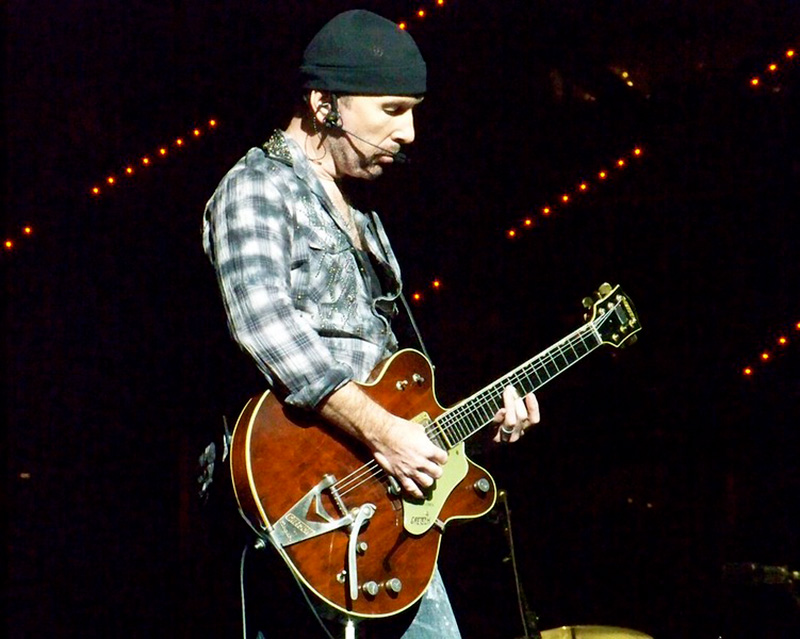
The Edge was born in England and raised in Ireland. In 1976 when he was 15 years old, he started a band with his classmates at school and his older brother Dik. After a few lineup changes, the band eventually evolved into U2. With his unique genre-merging style, The Edge and U2 became a worldwide sensation, earning countless commendations including 22 Grammy Awards and an induction into the Rock and Roll Hall of Fame in 2005. He’s currently ranked 35th on Rolling Stone’s 100 Greatest Guitarists list.
What Guitars Does The Edge Use?
The Edge primarily plays Black Fender Stratocaster guitars. Despite having a vast and continuously rotating catalog of Les Pauls, Explorers, and Gretsch Chet Atkins models, The Edge’s main guitars have always been Fender Stratocasters which is now his signature guitar.
See the full list of The Edge guitars and gear below.
The Edge Signature Fender Stratocaster
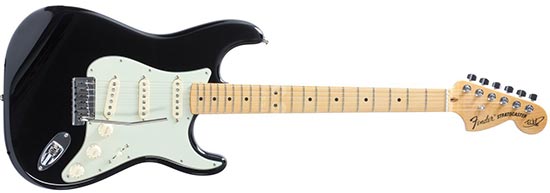
| Finish | Black |
| Years Used | 2016 to Present |
For a long time, the Edge refused to endorse any specific guitar. According to him, he’d “really, really have to believe in the thing.” He never wanted to be a “poster guy” in music shops telling people to buy this guitar.
After decades of rocking his old ’73 Stratocaster, the Edge finally found a guitar he could truly believe in. So in 2016, he teamed up with the experts at Fender to design his very first (and only) The Edge Signature Stratocaster.
The Edge’s goal was to take the best parts of the early ‘70s Strats and add some cool modern bits to create a guitar that’s the best of both worlds.
Design-wise, The Edge Signature Stratocaster is based heavily on his original 1973 Strat. It comes in a black finish (of course) and features the same neck profile and larger headstock. The Edge loved the larger headstocks on early Stratocasters, saying that they gave the guitar a better tone and sustain.
For pickups, the Edge went with Fat 50s in the neck and mid position, while sticking with his tried-and-true DiMarzio FS-1 in the bridge position as a mid-booster. Unlike any other Fenders, The Edge Signature Strat pickups aren’t staggered, and they’re wired in series.
Up top, the Signature Strat features a bone nut and locking tuners to make sure the guitar sounds its best and stays in tune for entire shows. The strings are connected to a two-point chrome tremolo bridge. According to the Edge, the two-point bridge had better sound and sustain than the typical three-point setup.
The Edge takes nine of his signature Stratocasters on tour. Some of them are in different tunings, and others are kept as backups. If a Strat fails, the Edge won’t just swap out for the nearest guitar. It has to be the same to maintain the tone! Most of the Edge’s signature Strats have 10-46 gauge strings, but that sometimes changes depending on the tuning. In the studio, he tends to use a wound G-string for a little more output.
Ever since he got his hands on this guitar its become his more frequented and battled six-string, it was largely used on the recording sessions for U2’s latest installment in 2016, “Songs of Experience”. You can see The Edge Signature Stratocaster on stage when U2 plays songs like “In the Name of Love.”
1973 Fender Stratocaster

| Finish | Black |
| Years Used | 1981 to Present |
The Edge’s first “professional-grade” guitar was a ‘70s Fender Stratocaster that he bought with his brother. It had a sunburst finish, and he and his brother shared the instrument, amp, and pedals for a few years in the late 1970s. This guitar came to replace their very first “very little modest guitar” which was rather similar to a Stratocaster.
As the Edge progressed in his career, he and his brother decided that they each needed their own sets of equipment. So, his brother kept the guitar, and the Edge took the amp. The Edge played a few different guitars over the next few years, but he missed playing his old Strat. When U2 got their first record deal and he scraped together a little money, the Edge set out to find another Stratocaster to add to his collection.
While in New York City, the Edge wandered over to the music shops on 48th street and started playing a few of the used instruments on the wall. The Edge believes that the right guitar inspires the playing. If it has the perfect sound for what you want to do, and you can just start feeling the parts pop into your head. When he picked up a black 1973 Fender Stratocaster, he instantly knew it was the guitar for him.
The Edge’s 1973 Strat had a black finish and a black pickguard. Unlike standard Stratocasters, this one had a brass tremolo bridge, which gave the guitar more resonance and sustain—perfect for the Edge’s echoey tone. This standard Strat and its sound would eventually inspire his Signature model.
The only thing he didn’t like about the guitar was the bridge pickup. He found the stock pickup to be too piercing and thin for what he wanted. After a few years, he swapped out the bridge pickup for a DiMarzio FS-1. It gave the guitar a bigger sound that worked better with his bright amps. Now, whenever he gets a new Stratocaster, the first thing he does is swap the bridge pickup to an FS-1.
The Edge’s ’73 Strat became one of his primary players and was used heavily on U2’s second album “October”. Once the Edge finds a guitar with the tone he likes, he keeps using it on certain songs forever. You can still see the iconic ’73 Stratocaster in action whenever U2 plays “Gloria.”
1976 Gibson Explorer
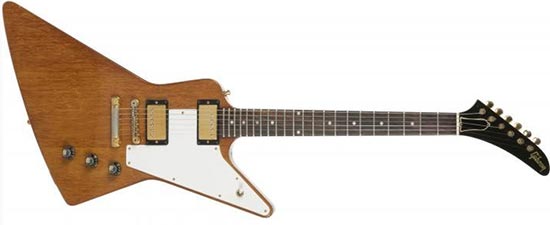
| Finish | Natural / Black |
| Years Used | 1978 to Present |
Although The Edge created an official signature Stratocaster, his unofficial signature model is probably a 1976 Gibson Explorer. This was Edge’s first guitar that he bought with the express purpose of joining a band and playing in front of a live audience, and it has become a mainstay in his rig ever since.
Back in 1978, when the Edge was 17 years old, his parents took him on vacation in New York City. He really wanted to buy a Les Paul, so he went to a few of the music shops in town. He started playing a few of the guitars and absolutely fell in love with the Explorer. He thought it looked funny and was worried about what his bandmates might say about the strange-looking instrument, but he just couldn’t get over the tone.
After he bought the Explorer, it became his primary instrument for many, many years. Since nobody else was playing Explorers at the time, the weird-shaped instrument helped give U2 a signature look on stage and made them almost famous for playing it.
Over the years, Edge’s Explorer has had a few accidents on stage. Most notably, the headstock was completely snapped off during a show at Radio City Music Hall in the mid-80s. During the show, the bouncers got a little heavy with the crowd and started pummeling some kids in the front row. The Edge didn’t like that at all, so he threw the guitar over his shoulder and ran down to help them out. Once the altercation was over, he went back on stage to find the headstock of his prized guitar hanging by a thread (or string, rather). Luckily, he got the guitar repaired, and it has been rocking on U2 stages for decades.
Even today, he still loves the sound of the 1976 Explorer. In fact, he now owns 11 Explorers, and all of them are 1976 models. Each one of them is bone stock, just as they came from the factory, some of them come in a black finish and one would be recently auctioned in 2008 for $80.000 that went to charity.
You can hear Edge’s favorite Gibson Explorer on several iconic U2 songs, including “Beautiful Day.” It even makes an appearance in the music video!
1963-1967 Gretsch Chet Atkins Country Gentleman
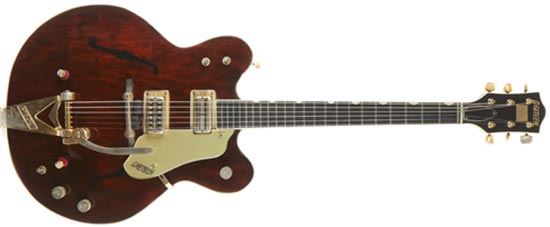
| Finish | Walnut |
| Years Used | 2008 to Present |
When slide playing is involved, the Edge turns to a vintage Gretsch Chet Atkins Country Gentleman. He likes the sound of the hollow-body design, which gives the guitar a smoother, softer sound.
The Edge’s primary Country Gentleman has a walnut finish and standard Gretsch pickups and tremolo tailpiece. The only alteration he made is to add a piezo pickup into the bridge to give the guitar a more acoustic tone.
Since U2 has only one guitar player, the Edge can’t afford to be pigeonholed into just playing slide. He needs to be able to fret and slide at the same time! To make the seemingly impossible happen, the Edge plays with a custom-made slide that’s small enough to fit on the top joint of his index finger. That way, he can play slide when he needs to, but he can also bend his finger to fret with his fingertip. It takes a lot of precision to pull off such a maneuver, but the Edge is a pro!
The Edge brings six Country Gentleman guitars (Gentlemen?) on tour, all made between 1963 and 1967. You can see the Edge’s Gretsch Chet Atkins Country Gentleman and his incredible slide technique when U2 plays “City of Blinding Lights.”
Popular Related Article: What Guitar Did Jimmy Page Play?
1966-1967 Rickenbacker 330-12
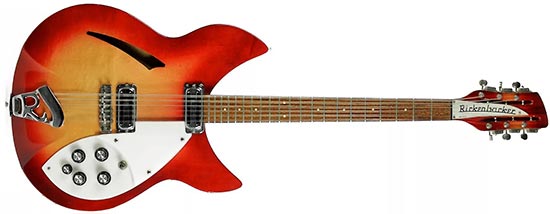
| Finish | Sunburst/Maple Natural |
| Years Used | 1991 to Present |
The Edge was fascinated by Pete Townsend’s “punk” style, and Townsend was always playing a Rickenbacker 330-6. He thought it was so unique and decided that he should get his own Ric. Of course, the Edge isn’t interested in copying anyone’s tone; he’s an original. Instead of getting the six-string Townshend had, the Edge decided to go for the 330 12-string.
The Rickenbacker 330-12 is the same as the 330-6, just with some extra strings. It’s a semi-hollow guitar that gives off a great warm tone. It has two single-coil pickups and a double-cutaway body shape that allows complete access to the 24-frets on the neck. The Edge absolutely loves the way it resonates.
If you’re like many guitar players, you’ve probably wondered at one point or another how the Edge gets his “dive bomb” tone for the song “Mysterious Ways.” Well, a lot of it has to do with the guitar. He uses the Rickenbacker 330-12 paired with an auto-wah pedal to create the unique sound!
The Edge has two Rickenbacker 330-12s in his arsenal: a red sunburst 1966 model and a maple 1967 model. They’ve been reportedly used in every record since “Pop” back in 1997.
1975 Gibson Les Paul Custom
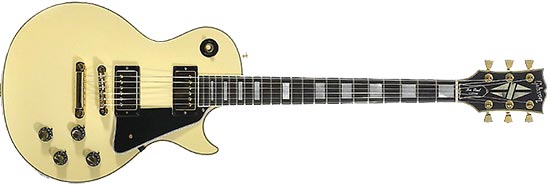
| Finish | Alpine White (Cream) |
| Years Used | 1982 to 2007/ 2008 to Present |
In 1982, the Edge went out and bought his third “real” guitar after his Explorer and black Strat. This time, he finally decided to get the guitar he had always wanted: a bonafide Gibson Les Paul.
At the time, the Edge was listening to Sex Pistols’ Steve Jones and really wanted to get the sound he had on the album Never Mind the Bollocks. Well, the Edge never found the tone, but the Alpine White 1975 Gibson Les Paul he bought (the same guitar Jones used, right down to the color) gave him plenty of songs and tones to use in upcoming U2 albums.
The Edge’s ’75 Les Paul was completely stock. He never made any modifications to the guitar. The only thing that differentiated this guitar from something that came off the factory line was a decal on the back that had the number two.
The Edge used his Les Paul extensively on the next few U2 albums—especially Achtung Baby—and hundreds of live shows over the years. You can even see the guitar in the music video for “The Fly.” He used the guitar so much that the original Alpine White finish turned into more of a cream color.
In 2005, New Orleans was devastated by Hurricane Katrina. Edge and his bandmate Bono have always been heavily involved in charity efforts all over the world, and they decided to lend their star power to help the people affected by the natural disaster.
To raise money for the people of New Orleans, the Edge donated his prized 1975 Les Paul to be auctioned off for Hurricane Katrina relief. The guitar sold for an incredible $288,000. Although he was able to make a positive impact for a lot of people, it also meant the Edge couldn’t play his favorite Les Paul anymore. At least… so he thought.
A few years later, the Edge’s guitar tech received a UPS package at his house. When he opened it, he found the 1975 Cream Gibson Les Paul, complete with every scratch, knick, and even the “2” decal. He immediately called Edge to ask if he knew it was coming. The Edge had no clue, and he definitely didn’t know why someone would send a quarter-of-a-million-dollar guitar through UPS instead of hand-delivering it.
As it turns out, the Edge’s friends at Gibson just couldn’t see him go without his prized LP and decided to make an exact replica of his original Cream guitar, so the two could keep rocking shows all over the world.
Since he’s such a tone aficionado, the Edge was skeptical that any other guitar could sound as good as his original ’75. When he plugged it in, he couldn’t believe it. It sounded exactly like his original! The Edge and his iconic ’75 Cream Les Paul Custom (replica) were back in action and have been playing shows all over the world ever since.
Popular Related Article: Jack White Guitars Rundown
Gibson Les Paul Music Rising
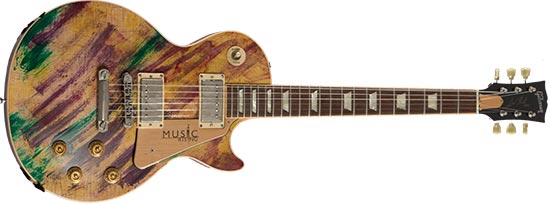
| Finish | Hand Painted Mardi Gras |
| Years Used | 2006 to Present |
When Hurricane Katrina struck Louisiana back in 2005, the Edge wanted to visit and do what he could to help the people of New Orleans. Being a music city, so many people had lost their instruments to the floodwaters, so the Edge and Gibson came up with a plan to help.
Together, they designed a special Les Paul that would be made in a very limited production run of only a couple hundred guitars. All the proceeds would go straight to the hurricane relief efforts for those affected.
Each Gibson Les Paul Music Rising, as it became known, was uniquely hand-painted in bright Mardi Gras colors to celebrate the musical heritage of New Orleans. While the body wood is what you’d find in a typical Les Paul, the accents like the pickguard, back panels, and truss rod cover are made from reclaimed wood from trees affected by the hurricane. All in all, it’s a very special guitar.
He says that its tone is much warmer than his 1975 Les Paul, especially when he plays with his thumb and finger. Additionally, he played and signed several models under the Rising Katrina foundation only to auction them and reopen several venues.
1966 Fender Telecaster

| Finish | Vintage Yellow |
| Years Used | 2005 to Present |
When U2 was recording the song “Vertigo,” the Edge was working on a few riffs in his house in Malibu, California. He simply couldn’t find a guitar that had the tone he wanted, so he reached out to his guitar tech and asked him to grab something and bring it to his house. His tech ran into LA to a music store called Westwood. On the wall, he saw a yellow 1966 Fender Telecaster. He grabbed the guitar and a little ’59 Deluxe amp and took them both to the Edge.
The guitar was exactly what the Edge was looking for! The ’66 was super bright, and it sounded great when paired with the amp. He loved the sound so much that he used both the guitar and the amp to record “Vertigo.”
The Edge’s 1966 Telecaster is completely stock. The only “odd” thing about the guitar is the numbers on the pickguard. But don’t overthink it; there’s no meaning behind them. They were there when the Edge bought the guitar, and he never took them off. The Edge typically uses only the bridge pickup because he wants that famous Tele brightness.
Although the Edge owns several Telecasters in a variety of years and finishes, his yellow ’66 is the go-to. You can see it on stage just about any time U2 plays “Vertigo” live.
Related Article: What Guitar Did BB King Play?
Taylor Prototype
| Finish | Natural |
| Years Used | 2018 to Present |
Acoustic guitars are tricky for the Edge to play on stage. Because they rely on body contours instead of electronics to produce their sound, it’s much harder to dial in the tone on a live stage. As you know, the Edge must have a precise tone. So, he needed an acoustic that could give him what he wanted. The pros at Taylor stepped up and built the Edge a guitar designed to suit his specifications.
The Edge’s Taylor prototype is both a Jumbo and a Dreadnaught. It has a larger bottom end and high shoulders, blending the two body types into one incredible guitar. This acoustic has two pickups. The first is the standard bridge piezo that runs through the onboard Fishman electronics, identical to what you’d find in standard Taylors. The second is an offset soundhole pickup that the Edge installed himself.
Installing the soundhole pickup was quite the process. The Edge would tweak the offset by ear until it sounded “right.” He’d install the pickup, strum a few notes, and if it didn’t sound exactly like how he wanted, he’d uninstall it and rotate it around in the soundhole. He repeated the process until it was absolutely perfect.
Most of the amplified sound comes from the soundhole pickup, but the Edge can mix the two sets of electronics to blend his perfect tone.
The Edge plays D’Addario bronze 11-52 gauge strings on his acoustic and tunes it a semi-tone down. You can hear this incredible acoustic in action in this video of U2 rehearsing for the Experience + Innocence tour in 2018.
Table Showing Each Guitar The Edge Has Played at Every point in His Career
| Make | Model | Color/Finish | Years |
|---|---|---|---|
| Gibson | 1976 Explorer | Natural | 1978 to Present |
| Fender | 1973 Stratocaster | Black | 1981 to Present |
| Gibson | 1975 Les Paul Custom | Alpine White (Cream) | 1982 to 2007/ 2008 to Present |
| Rickenbacker | 1966-1967 330-12 | Sunburst/Maple Natural | 1991 to Present |
| Fender | 1966 Telecaster | Vintage Yellow | 2005 to Present |
| Gibson | Les Paul Music Rising | Hand Painted Mardi Gras | 2006 to Present |
| Gretsch | 1963-1967 Chet Atkins Country Gentleman | Walnut | 2008 to Present |
| Fender | The Edge Signature Stratocaster | Black | 2016 to Present |
| Taylor | Prototype | Natural | 2018 to Present |
The Edge Amplifier Overview
Unlike his guitar collection that includes just about every make and model, Edge’s amps have remained relatively steady over the decades. Although he may tweak the mix, he has used the same Fender and Vox combo amps for the majority of his career.
Of course, you won’t see any amps on a U2 stage. The band decided to leave their equipment off stage, so it doesn’t get in the way of all the art and imagery that accompanies their shows. All the amps are under the stage in a padded area, so they don’t blow the techs’ ears out (too much, at least), and mic’d to the front of the house PA speakers.
1964 Vox AC30 Top Boost “Vox 1”
The Edge’s number one amp is a 1964 Vox AC30 with top boost. This amp has been in the Edge’s arsenal since the 1960s and has been a part of all the big hits of his career, including “With or Without You” and “Bullet.” Since it’s the Edge’s number one amp, he calls it “Vox 1.”
The Edge used this amp so much over the years that it started to get worn out. Who wouldn’t feel a bit tired after decades of 12-hour days!? To conserve his beloved original, the Edge reached out to the pros at Vox to design another amp that sounded exactly like his original.
Vox came to the Edge’s rehearsal space and took video of all the ins and outs of the amp, hoping that they could recreate it back in their facility. What they found was that Vox 1 wasn’t entirely a Vox anymore. It had been repaired by so many different shops over the years that it had a hodgepodge of parts, including Marshall capacitors. All the random parts working together was what made the amp sound so good, and unique.
Vox ended up making several amps for the Edge to try out and see if they could even come close to his original. Luckily, one amp was close enough to Vox 1’s outstanding tone to make the Edge happy. It became Vox 2 and took a primary role in the Edge’s amp lineup. The original Vox 1 is still a part of the Edge’s live sound, but it plays more of a backup role.
One of the other amps that Vox custom made for the Edge didn’t have the same tone as Vox 1, but it had a “jangly” tone that the Edge really liked. Instead of sending it back, he kept it and added it to his five-amp setup, almost as an effect pedal. He used the “jangly” amp a good bit for the Experience album and subsequent tour.
1957/58 Fender Tweed Deluxe
The Edge’s three Vox amps are rounded out with vintage Fender amps, specifically the Tweed Deluxe. The Edge uses two Fender Tweed Deluxes: a 1958 model with a Vox speaker and a 1957 model with a Jensen speaker. It’s impossible to beat that vintage tone, and he swears you can hear the wood the old amp boxes are made from.
The Edge brings a few vintage Fender Tweed Deluxe amps on tour, with models ranging from 1956 to 1959. Although you might think a rock star like the Edge would crank his amps up, he usually runs his Tweed amps with the volume set to three.
The Edge Fender Deluxe
In 2016, as the Edge was working with Fender on his signature Stratocaster, he decided to add a cherry on top of an already perfect cake and design a signature amp, too. Since he loved the sound of the ‘50s model tweed amps, that’s what he wanted to make.
The Edge Fender Deluxe amp is a combination of all the things that made the old amps great with a few modern twists. The designs are based on the vintage models with a tried-and-true Celestion 12-inch speaker.
Every single signature amp is hand-wired, so no two sound exactly the same. While that might sound like a nightmare for a tone nut like the Edge, it really means that he has a lot of different sounds to add to his repertoire. One signature amp, in particular, had a nice crunchy sound that he uses quite frequently. If you hear the Edge with a crunchy sound, it’s his signature Fender Deluxe amp.
You can hear the Edge talk about the process of building his signature amp in this video from Fender.
1956 Fender Harvard
The final amp in the Edge’s lineup is a rare 1956 Fender Harvard. The Edge loves the sound of the old ‘50s Fender amps, but there was something missing with his Tweed Deluxes. They just didn’t have the mid-range he was looking for. To make up for the sound, he added the vintage Harvard to the mix.
The Fender Harvard was originally a mid-range amp, designed to fit between the beginner Champ and the professional Deluxe models. They were only made between 1955 and 1963, making them extremely rare and collectible.
When the Edge got his hands on one, he couldn’t believe the mid-range that it put off. He quickly snatched up a few and added them to his amp rig to give him the full tone he was looking for.
The Edge Pedals and Effects
The Edge works hard to perfect his tone for every song he plays. To dial the sound in, he has used hundreds of effects pedals over the years, especially delays, distortions, and echoes. Here’s a rundown of the Edge’s pedalboard and the various effects he uses on stage and in the studio.
Custom Audio Electronics Bradshaw Switcher
The Edge keeps most of his effects in his rack under the stage. To control them remotely, everything runs through a Custom Audio Bradshaw switcher with 40 (yes, 40) available effect combination presets.
Some of the buttons control individual effects like the B9 Organ or the FET, while others control amp combinations that allow him to turn specific amps on and off in real time as he sees fit. A few of the buttons are preset for certain songs. When a certain track comes up in the setlist, he can simply hit that button with his foot and all the right effect pedals kick into action, giving him the exact tone he needs.
This is the heart of the Edge’s pedalboard. He does almost all the effects switching himself while he’s playing on stage.
Dunlop Expression Pedals
Aside from the Bradshaw switcher, the only other physical pedals on the Edge’s side of the stage are various expression pedals. These pedals control some standard effects that you’d expect to pair with an expression pedal like wah and volume, while others are connected to more interesting effect choices.
Here are the effects the Edge controls with Dunlop expression pedals:
- Wah
- Reverb
- Delay
Instead of turning the knobs on the pedal itself, the Edge can adjust settings on his reverb and delay like length or depth with his foot in real time as he’s rocking on the stage—sometimes right in the middle of songs! The Edge wants complete control over his tone, and these expression pedals are how he does it.
Ibanez Tube Screamer TS9
At the heart of many rock guitarists’ pedalboards sits a little green pedal known as the Ibanez Tube Screamer. When you want some distortion, this is the pedal to have.
The Edge has an Ibanez Tube Screamer in his rack to give him that little taste of distortion he needs. If you want to sound like the Edge, this pedal is a must-have.
Line 6 DM-4
While the Ibanez Tube Screamer is a great pedal, the Edge wanted a little bit more control over his tone than what the three little dials on the Ibanez could give him. So, he reached out to the effect experts at Line 6 to craft him a custom distortion pedal to suit his needs.
Line 6 came up with a completely custom gold DM-4 pedal that’s “MIDI-able.” It can digitally alter and combine tones to create dozens of distortion sounds that the Edge can use throughout his show with the click of a button on his switcher. It gives him all the control over his distorted tone that he could ever need.
Korg SDD-3000
The cornerstone of the Edge’s sound is his incredible echo. To create the effect, the Edge has used a Korg SDD-3000 digital delay pedal almost exclusively since the 1980s.
The SDD-3000 allows for countless combinations of delay effects by giving the player control over dozens of settings:
- Delay time
- Waveform
- Intensity
- Frequency
- Balance
- Feedback
- Regeneration
- And more
Obviously, with that level of control, the Edge just had to have one. Unfortunately, Korg discontinued the SDD-3000 for several years, but that didn’t stop the Edge from using one in his effects rack. He has collected dozens of SDD-3000s for both backups and parts. No matter how rare they get, the Edge will likely always have an SDD-3000 controlling his delay sound on stage and in the studio.
TC Electronic 2290 Dynamic Digital Delay
In addition to the powerful SDD-3000, the Edge uses a TC Electronic 2290 digital delay for even more echoey power. It comes with amazing features like modulation, compressors, four ports (loops), and an incredible 32-second delay time.
The 2290 is a rack-mounted delay effect that gives the user even more control over the sound. Unlike the SDD-3000, which is a global output-only effect, the 2290 allows the user to control both the input and the output. If an effect allows more control over the tone, the Edge has to have it.
FET Boost
The FET boost pedal gives the Edge a slight boost (obviously) but without distorting his tone. It keeps the integrity of the signal, so it’s literally the precise tone that the Edge has worked so hard to achieve, just a bit louder.
The Edge plays with such incredible amps that he doesn’t want to muddle his tone too much with pedals. If he wants some distortion, he’d rather the tone come from the amps. That’s why the FET boost always has a place on the Edge’s pedalboard.
Electro-Harmonix B9 Organ Machine
The Electro-Harmonix B9 Organ Machine does exactly what the name implies: It makes your guitar sound like an organ with all its warbly goodness. The Edge keeps a B9 Organ Machine pedal in his rack for that smooth-sounding tremolo that you can only get from an organ.
Diamond Vibrato
The Diamond Vibrato is an analog vibrato pedal with a true bypass and four knobs for complete control over the sound. It lets the user control settings including volume (which is very important for blending), chorus, depth, and speed.
The Edge uses this vibrato pedal in his rack to gives his tone that unique depth that only a vibrato effect can provide.
Wrap Up
The Edge is considered a sound pioneer. He’s always searching for that perfect tone to suit the song he’s working on. Because of his need for perfect sound, this particular mannerism of his has led him to accumulate mountains of equipment just for his renowned trial and error process. Needless to say, this man is largely responsible for U2’s distinctive and bombastic sound -proving not everything is about Bono.
Even after over 45 years of playing, the Edge is still working hard with his bandmates in U2. While there aren’t any concrete plans for a new album in the near future, fans can look forward to the re-release of the U2 album All That You Can’t Leave Behind scheduled for October 2021.
In addition to his musical work, the Edge has also poured himself into philanthropic work that includes cooperation with dozens of charities all over the world. He’s dedicated to making the world a better place, either through his incredible music or directly working with people in need. Not only is the Edge a world-class guitar player, but he’s also a world-class human being.

My name is Chris and I’ve had a passion for music and guitars for as long as I can remember. I started this website with some of my friends who are musicians, music teachers, gear heads, and music enthusiasts so we could provide high-quality guitar and music-related content.
I’ve been playing guitar since I was 13 years old and am an avid collector. Amps, pedals, guitars, bass, drums, microphones, studio, and recording gear, I love it all.
I was born and raised in Western Pennsylvania. My background is in Electrical Engineering, earning a Bachelor’s degree from Youngstown State University. With my engineering experience, I’ve developed as a designer of guitar amplifiers and effects. A true passion of mine, I’ve designed, built, and repaired a wide range of guitar amps and electronics. Here at the Guitar Lobby, our aim is to share our passion for Music and gear with the rest of the music community.

thank you for posting the photo of my guitar